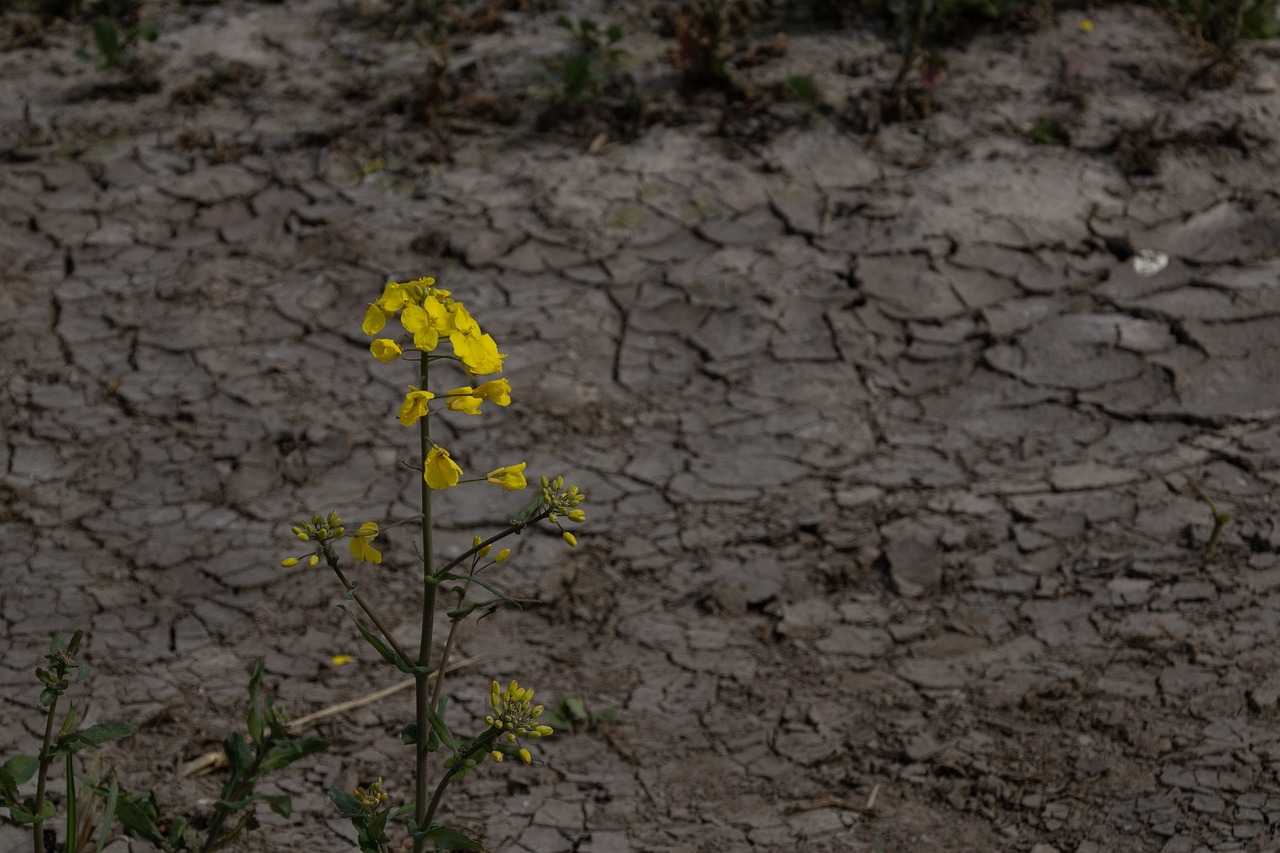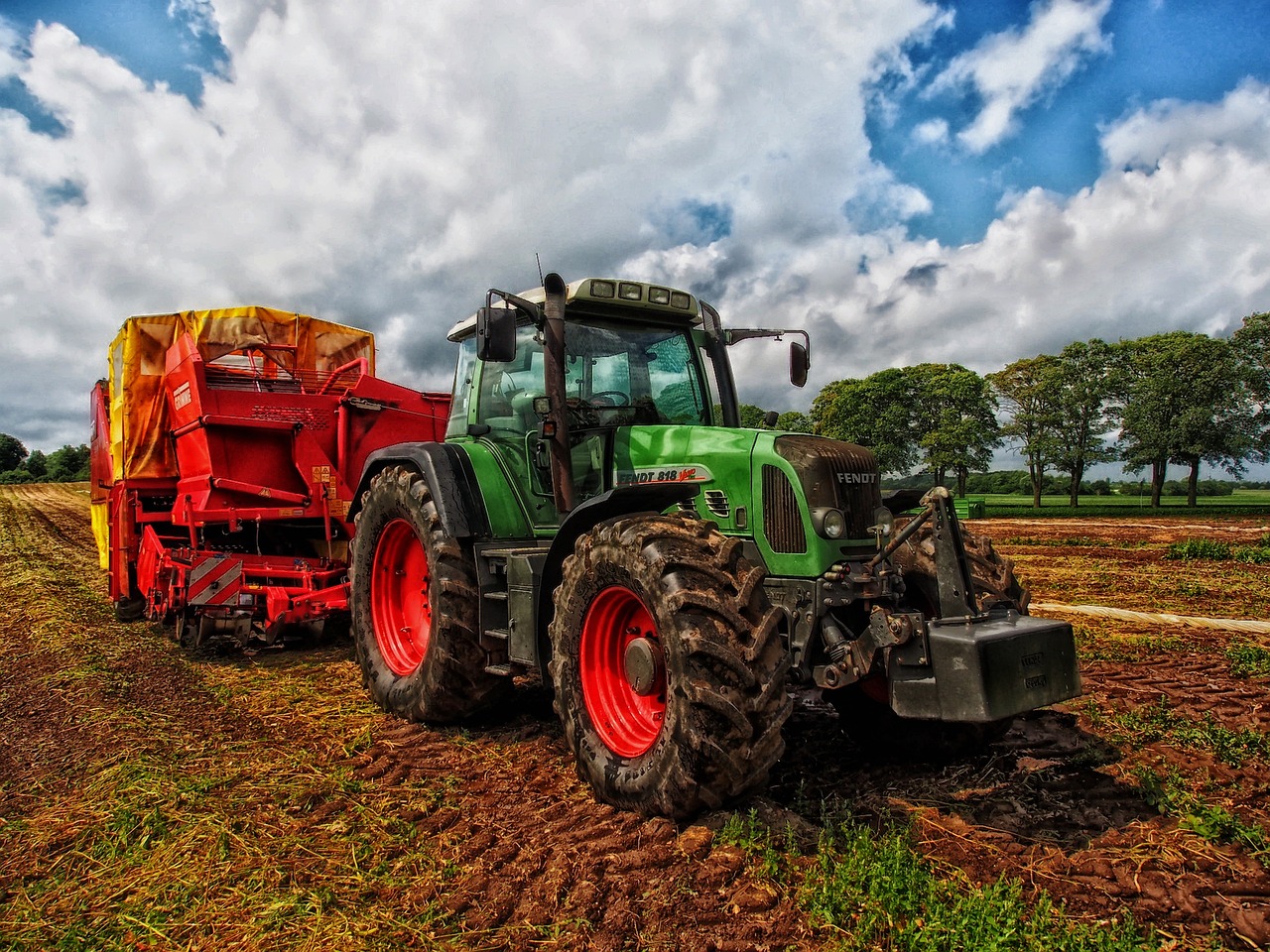Climate Change's Role in Lowering Crop Nutrition
Climate change is not just a distant threat; it's a reality that is reshaping our world, and one of the most alarming impacts is on our food supply. As temperatures rise and weather patterns shift, the nutritional quality of the crops we rely on is taking a hit. Imagine biting into a juicy tomato or a crisp carrot, only to find that it’s lost some of its essential vitamins and minerals. This isn't just an inconvenience; it poses serious risks to our health and food security. In this article, we will delve into the intricate ways climate change is affecting agriculture and, by extension, our nutrition.
The connection between climate change and crop nutrition is complex and multifaceted. As farmers face increasingly unpredictable weather, they struggle to maintain the quality of their crops. High temperatures can stress plants, leading to reduced yields and lower nutrient absorption. For instance, studies have shown that elevated CO2 levels can actually decrease the protein content in staple grains like wheat and rice. This is a wake-up call for all of us, as it highlights a pressing need to adapt our agricultural practices to ensure we can still produce nutritious food in the face of climate challenges.
Furthermore, the implications of these changes extend beyond just farmers; they affect everyone who consumes food. With the global population expected to reach nearly 10 billion by 2050, the stakes are higher than ever. If we don't address the nutritional decline of our crops, we risk creating a future where food is plentiful but lacking in essential nutrients. This could lead to widespread health issues, particularly in vulnerable populations who may already be facing food insecurity. Therefore, understanding how climate change impacts crop nutrition is not just an academic exercise; it's a crucial step towards safeguarding our health and future.
In the following sections, we will explore the various dimensions of this issue, including the impact of rising temperatures, changing precipitation patterns, and soil degradation. Each of these factors plays a significant role in the nutritional quality of our crops, and together they paint a troubling picture of the future of food. But it's not all doom and gloom; there are also strategies we can implement to mitigate these effects and promote sustainable agricultural practices. Stay tuned as we unravel the complexities of climate change and its role in lowering crop nutrition.

Impact of Rising Temperatures
As the planet warms, we are witnessing a dramatic shift in agricultural landscapes. Rising temperatures are not just a number on a thermometer; they are a force that reshapes how crops grow and thrive. Imagine trying to grow a delicate flower in a scorching desert—this is akin to what our crops are facing today. Increased global temperatures can lead to a variety of detrimental effects on crop growth and nutrient absorption, ultimately resulting in diminished yields and a significant drop in nutritional value.
One of the most pressing concerns is how heat stress impacts plant physiology. When temperatures soar, plants may struggle to maintain their normal functions. For instance, high temperatures can lead to increased respiration rates, causing crops to use up their energy reserves faster than they can replenish them. This not only affects their growth but also their ability to absorb essential nutrients from the soil. Without adequate nutrient absorption, crops become less nutritious, which poses a serious risk to human health.
Moreover, the rising temperatures can lead to a phenomenon known as "heat shock," where plants experience stress that can trigger a cascade of negative effects. These include:
- Reduced photosynthesis efficiency
- Increased vulnerability to pests and diseases
- Altered flowering times and pollination processes
As we delve deeper into the implications of these temperature increases, it’s important to note that different crops respond uniquely to heat stress. For instance, staple crops like wheat and rice may experience significant reductions in yield, while other crops like certain fruits may suffer from poor quality due to heat-induced stress. This variability can lead to unpredictable outcomes for farmers, who must adapt quickly to these changing conditions.
To illustrate the impact of rising temperatures on crop yields, consider the following table:
| Crop Type | Temperature Increase (°C) | Expected Yield Reduction (%) |
|---|---|---|
| Wheat | 1 | 6 |
| Rice | 2 | 10 |
| Corn | 3 | 15 |
As farmers grapple with these challenges, it becomes increasingly clear that understanding the effects of rising temperatures is crucial for developing effective strategies to mitigate climate-related agricultural challenges. Adapting farming practices, selecting heat-resistant crop varieties, and investing in innovative agricultural technologies are just a few ways to combat the adverse effects of climate change. However, these solutions require collaboration among scientists, farmers, and policymakers to ensure a sustainable future for our food systems.
In conclusion, the impact of rising temperatures on crop nutrition is a multifaceted issue that demands immediate attention. As we strive to secure our food supply in the face of climate change, we must prioritize research and action to protect our crops and, ultimately, our health.

Changing Precipitation Patterns
When we talk about climate change, one of the most significant aspects that often gets overlooked is the alteration of precipitation patterns. Imagine a world where rain is no longer predictable; one year, you might be drowning in torrential downpours, while the next, you're watching your crops wither under a relentless sun. This inconsistency can wreak havoc on agricultural practices, leading to dire consequences for both crop growth and nutritional content.
In many regions, rainfall has become increasingly erratic, with some areas experiencing intense storms and flooding, while others suffer from prolonged droughts. This shift not only affects the quantity of water available for crops but also the timing of when that water arrives. For farmers, this means they must adapt their planting schedules and irrigation practices, often with little guidance on how to navigate these new challenges. The result? Crops may not receive the necessary water at critical growth stages, leading to stunted growth and lower yields.
Moreover, the quality of water is just as important as the quantity. Increased rainfall can lead to runoff that carries pollutants and nutrients away from the fields, further reducing the quality of the soil and the crops that grow in it. When essential minerals and nutrients are washed away, the crops that remain may not only yield less but also lack the vital nutrients needed for a healthy diet.
To illustrate the extent of this issue, consider the following table that highlights the impact of changing precipitation patterns on agricultural productivity:
| Region | Impact of Precipitation Changes | Crop Yield Change (%) |
|---|---|---|
| Midwest USA | Increased flooding and soil erosion | -15% |
| Sub-Saharan Africa | Prolonged droughts and reduced water availability | -20% |
| Southern Europe | Irregular rainfall leading to crop stress | -10% |
As we can see, the implications of changing precipitation patterns are not just theoretical; they are having real-world effects on our food supply. Farmers are left with the daunting task of adjusting to these changes while also trying to maintain crop quality. This situation is further complicated by the fact that many farmers lack access to the latest technology and resources that could help them adapt. The cycle of unpredictable weather and inadequate resources creates a perfect storm for food insecurity.
In light of these challenges, it is crucial to explore innovative solutions. For instance, investing in sustainable irrigation practices and developing drought-resistant crop varieties can help mitigate some of the adverse effects of changing precipitation. Additionally, implementing better water management strategies can ensure that when it does rain, farmers can make the most of it. The future of our food supply may very well depend on our ability to adapt to these shifting patterns.
In conclusion, the changing precipitation patterns brought on by climate change are a significant threat to agricultural productivity and crop nutrition. As we move forward, understanding these changes and developing strategies to cope with them will be essential for ensuring food security and maintaining public health.
- How does climate change affect rainfall? Climate change leads to more extreme weather patterns, causing irregular rainfall that can result in both flooding and drought.
- What are the implications for farmers? Farmers face challenges in planning their planting and irrigation schedules, which can lead to lower crop yields and nutritional quality.
- What can be done to mitigate these effects? Sustainable farming practices, improved irrigation methods, and the development of resilient crop varieties are key strategies for adaptation.

Soil Degradation
Soil degradation is a pressing issue that exacerbates the challenges posed by climate change on agriculture. As the climate shifts, the health of our soils deteriorates, leading to a cascade of effects on crop nutrition. Healthy soil is akin to the foundation of a house; without it, everything built on top is at risk. When soil loses its fertility and nutrient-holding capacity, it directly impacts the quality and quantity of the food we produce. Farmers face an uphill battle as they attempt to cultivate crops in increasingly unyielding conditions.
One of the primary causes of soil degradation is the increased frequency of extreme weather events, such as heavy rainfall and droughts. These events not only erode the soil but also disrupt its structure, making it less capable of retaining water and nutrients. For instance, when heavy rains wash away the topsoil, the most fertile layer, the remaining soil becomes less productive. This is a double whammy: not only do farmers lose valuable land, but the crops grown in degraded soil often lack essential nutrients. The implications for public health are staggering, as a decline in crop nutrition can lead to widespread deficiencies in the population.
Moreover, the relationship between soil health and crop nutrition is intricate and multifaceted. Soil acts as a living ecosystem, home to a myriad of microorganisms that play a crucial role in nutrient cycling. When soil health declines, so does the diversity and activity of these microbial communities. This disruption can hinder the availability of essential nutrients, making it difficult for plants to absorb what they need to thrive. As a result, even if farmers apply fertilizers, the effectiveness may be compromised due to the poor condition of the soil.
To combat soil degradation, sustainable agricultural practices are imperative. These practices not only help restore soil health but also enhance its resilience against climate change. Some key strategies include:
- Crop Rotation: Alternating different crops can help maintain soil fertility and reduce pest populations.
- Cover Cropping: Planting cover crops during off-seasons protects the soil from erosion and adds organic matter.
- No-Till Farming: Reducing tillage preserves soil structure and minimizes disturbance to microbial communities.
In conclusion, understanding and addressing soil degradation is crucial for maintaining crop nutrition in the face of climate change. As we strive to secure our food systems, it’s essential to recognize that healthy soil is not just a resource; it’s the very backbone of agriculture. Without proactive measures to restore and protect our soils, we risk jeopardizing not only agricultural productivity but also public health and food security for future generations.
Q1: What are the main causes of soil degradation?
A1: The main causes of soil degradation include erosion from extreme weather events, overuse of chemical fertilizers, deforestation, and poor agricultural practices.
Q2: How does soil degradation affect crop nutrition?
A2: Soil degradation reduces the soil's fertility and nutrient-holding capacity, leading to lower crop yields and diminished nutritional quality of the food produced.
Q3: What practices can help restore degraded soil?
A3: Sustainable practices such as crop rotation, cover cropping, and no-till farming can help restore the health of degraded soils and improve crop nutrition.
Q4: Why is microbial activity important for soil health?
A4: Soil microorganisms play a crucial role in nutrient cycling, helping to break down organic matter and make nutrients available to plants. A healthy microbial community is essential for maintaining soil fertility.

Effects of Erosion
Erosion is like a thief in the night, quietly stealing away the very foundation of our agricultural systems. When extreme weather events occur, such as heavy rains or strong winds, they can wash away the topsoil, which is the most nutrient-rich layer of soil that crops rely on for growth. This loss of topsoil is not just a minor inconvenience; it has profound implications for crop nutrition and agricultural productivity.
Imagine trying to grow a plant in a pot with no soil. That’s essentially what happens when erosion strips away the top layer. Without this vital resource, crops struggle to absorb the nutrients they need to thrive. The consequences of this erosion can be devastating, leading to lower yields and diminished nutritional quality in the food we produce. With the world’s population growing, this is a challenge we cannot afford to ignore.
Moreover, the effects of erosion go beyond just the immediate loss of soil. The displaced soil can end up in waterways, causing sedimentation that affects aquatic ecosystems and drinking water quality. This interconnectedness of our environment means that erosion can have ripple effects, harming not just agriculture but also public health and biodiversity.
To combat erosion effectively, we need to adopt sustainable agricultural practices. Here are a few strategies that can help:
- Cover Cropping: Planting cover crops during off-seasons helps to hold the soil in place and adds organic material to the soil.
- Contour Farming: This method involves plowing and planting across the slope of the land, which helps reduce water runoff and soil loss.
- Terracing: Creating terraces on steep slopes can slow down water runoff and reduce erosion.
By implementing these practices, farmers can not only protect their soil but also enhance the nutritional quality of their crops. It’s a win-win situation that underscores the importance of maintaining soil health in the face of climate change.
Q: What are the main causes of soil erosion?
A: The primary causes of soil erosion include water runoff, wind, deforestation, and poor agricultural practices that leave soil exposed.
Q: How does erosion affect crop yields?
A: Erosion removes the nutrient-rich topsoil, which is essential for healthy crop growth, leading to reduced yields and lower nutritional quality.
Q: Can erosion be reversed?
A: While it’s challenging to completely reverse erosion, implementing sustainable practices can significantly reduce its impact and help restore soil health over time.
Q: How does erosion impact food security?
A: Erosion threatens food security by decreasing agricultural productivity and the nutritional quality of crops, making it harder to feed a growing population.

Soil Microbial Activity
The intricate world of plays a pivotal role in determining the nutritional quality of our crops. These tiny organisms, which include bacteria, fungi, and protozoa, are the unsung heroes of the soil ecosystem. They are responsible for breaking down organic matter, cycling nutrients, and enhancing soil structure. However, climate change is shaking up this delicate balance. As temperatures rise and weather patterns shift, the composition and activity of these microbial communities can be severely affected.
For instance, increased temperatures can lead to a decline in microbial diversity. When certain species thrive due to warmer conditions, others may struggle or even disappear. This loss of diversity is concerning because a rich variety of microbes is essential for maintaining soil health. They contribute to nutrient availability, which directly impacts crop nutrition. If we think of soil as a buffet, a diverse microbial community ensures that every nutrient is well-represented, catering to the needs of the plants. However, when certain microbes are lost, it’s like removing dishes from the buffet—some nutrients might become scarce.
Moreover, climate-induced changes in moisture levels can further complicate matters. Microbes require a specific range of moisture to function optimally. Too much or too little water can hinder their activity, leading to nutrient cycling disruptions. For example, drought conditions can reduce microbial populations, while excessive rainfall can wash away nutrients before they can be utilized by crops. This fluctuation creates a challenging environment for farmers who rely on consistent soil health for optimal yields.
To illustrate the impact of soil microbial activity on crop nutrition, consider the following table that summarizes the effects of climate change on key microbial functions:
| Microbial Function | Impact of Climate Change | Consequences for Crop Nutrition |
|---|---|---|
| Nutrient Cycling | Altered temperatures and moisture levels | Reduced availability of essential nutrients |
| Organic Matter Decomposition | Increased heat stress | Slower breakdown of organic matter, leading to nutrient deficiencies |
| Soil Structure Improvement | Extreme weather events | Compacted soils, reducing root penetration and nutrient uptake |
As we navigate the challenges posed by climate change, it is essential to adopt sustainable agricultural practices that support microbial health. Practices such as crop rotation, cover cropping, and minimizing soil disturbance can help maintain a thriving microbial community. By fostering a healthy soil ecosystem, we can enhance nutrient availability for crops, ultimately leading to improved food quality and security. Understanding the relationship between climate change and soil microbial activity is not just an academic exercise; it’s a crucial step toward ensuring that our crops remain nutritious in the face of environmental changes.
- What is soil microbial activity?
Soil microbial activity refers to the processes carried out by microorganisms in the soil, including nutrient cycling, organic matter decomposition, and soil structure improvement. - How does climate change affect soil microbes?
Climate change can alter temperature and moisture levels, impacting microbial diversity and activity, which in turn affects nutrient availability for crops. - Why is microbial diversity important for crop nutrition?
A diverse microbial community ensures a balanced nutrient supply, facilitating optimal plant growth and nutritional quality. - What practices can enhance soil microbial health?
Practices like crop rotation, cover cropping, and reduced tillage can help support and enhance soil microbial communities.

Crop Variety Adaptation
As the climate continues to change, the adaptability of crop varieties has become more crucial than ever. Farmers are facing a reality where traditional crops may no longer thrive in the new environmental conditions. This is not just a minor inconvenience; it poses a serious threat to food security and nutrition. Imagine planting your favorite tomato seeds, only to find that they struggle to survive in the rising temperatures and shifting rainfall patterns. This scenario is becoming all too common, and it highlights the urgent need for resilient crop varieties that can withstand these changes.
One of the most effective ways to combat the adverse effects of climate change on agriculture is through the selection and development of crop varieties that are better suited to survive and thrive in altered conditions. This means looking for crops that can tolerate drought, resist pests, and maintain their nutritional value even when faced with environmental stressors. For instance, scientists are now working on developing heat-resistant wheat and drought-tolerant maize, which can significantly contribute to food stability in regions most affected by climate change.
In addition to developing new varieties, it's essential to consider diversification. By planting a wider range of crops, farmers can reduce their vulnerability to climate extremes. This approach not only helps in maintaining a stable food supply but also supports soil health and biodiversity. For example, intercropping—growing two or more crops in proximity—can lead to better nutrient utilization and improved resilience against pests and diseases.
However, the journey towards crop variety adaptation is not without its challenges. Farmers need access to resources, knowledge, and support to make informed decisions about which varieties to plant. This is where agricultural extension services and research institutions play a vital role. They can provide farmers with the necessary information about the best practices for selecting and cultivating resilient crops tailored to their specific regions.
Furthermore, the implications of crop variety adaptation extend beyond just agricultural productivity. It also has significant impacts on public health. By ensuring that crops maintain their nutritional quality, we can combat malnutrition and improve overall health outcomes in communities. A recent study indicated that certain resilient varieties of crops not only yield better under stress but also have higher levels of essential nutrients compared to their traditional counterparts.
In conclusion, as we navigate the uncharted waters of climate change, the adaptability of crop varieties is a beacon of hope. By focusing on developing and promoting resilient crops, we can safeguard our food systems and ensure that future generations have access to nutritious food. The time to act is now—let's embrace innovation and collaboration to build a more sustainable agricultural future.
- What are resilient crop varieties? Resilient crop varieties are those that can withstand adverse environmental conditions such as drought, heat, and pests, while maintaining their yield and nutritional quality.
- How can farmers access resilient crop varieties? Farmers can access resilient crop varieties through agricultural extension services, research institutions, and seed banks that specialize in developing and distributing these crops.
- Why is crop diversity important? Crop diversity helps reduce vulnerability to climate extremes, supports soil health, and contributes to a stable food supply, enhancing resilience in agricultural systems.
- What role does public health play in crop adaptation? Maintaining the nutritional quality of crops is essential for combating malnutrition and improving health outcomes, making crop adaptation critical for public health.

Nutritional Composition Changes
As we delve into the intricate relationship between climate change and crop nutrition, it's essential to recognize that the very fabric of our food supply is undergoing a transformation. Research has shown that rising temperatures, fluctuating precipitation patterns, and increased levels of carbon dioxide are not just altering our climate; they are also significantly impacting the nutritional composition of staple crops that form the backbone of our diets. Imagine biting into a piece of fruit or a vegetable—what if that bite no longer contained the vitamins and minerals your body needs? This is the alarming reality we face as climate change progresses.
One of the most concerning aspects of these changes is the decline in essential nutrients found in crops. Studies have indicated that crops grown in higher carbon dioxide environments tend to have reduced levels of vital nutrients such as protein, iron, and zinc. For example, a recent study highlighted that wheat and rice, two of the world's most consumed grains, have seen significant drops in their nutrient levels due to climate stressors. This decline poses a serious threat, especially to populations that rely heavily on these staples for their nutritional needs.
To illustrate the impact of climate change on crop nutrition, consider the following table that summarizes the changes in nutrient levels in key crops:
| Crop | Protein Content (%) | Iron Content (mg/kg) | Zinc Content (mg/kg) |
|---|---|---|---|
| Wheat | 10.5 (down from 12.5) | 30 (down from 35) | 25 (down from 28) |
| Rice | 7.5 (down from 8.0) | 15 (down from 18) | 12 (down from 14) |
| Barley | 12.0 (down from 13.0) | 35 (down from 40) | 20 (down from 22) |
The implications of these shifts are profound. With the reduction in essential micronutrients, we face the risk of widespread nutritional deficiencies, particularly in vulnerable populations. Malnutrition is not just a problem of quantity but also quality. If we continue down this path, we may see an increase in health issues related to lack of proper nutrition, such as anemia and other deficiency-related diseases.
Moreover, the impact of climate change on crop nutrition extends beyond individual health. It has broader implications for food security worldwide. As the nutritional quality of our staple foods declines, the challenge of feeding a growing global population becomes even more daunting. We must ask ourselves: how can we ensure that everyone has access to not just enough food, but food that is rich in the nutrients necessary for a healthy life?
In response to these challenges, researchers and agricultural experts are exploring various strategies to enhance the resilience of crops. This includes developing biofortified crops that are bred specifically to have higher nutrient levels, as well as implementing sustainable farming practices that improve soil health and crop yield. The future of our food system depends on our ability to adapt and innovate in the face of climate change.
- What are biofortified crops?
Biofortified crops are genetically enhanced to contain higher levels of essential nutrients, helping to combat malnutrition. - How does climate change affect soil health?
Climate change can lead to soil degradation, reducing its fertility and capacity to retain nutrients. - What can be done to improve crop nutrition?
Implementing sustainable agricultural practices, selecting resilient crop varieties, and investing in research for biofortification are key strategies.

Impact on Micronutrients
The effects of climate change on agriculture extend beyond just crop yields; they significantly influence the micronutrient composition of staple foods. Micronutrients, which include essential vitamins and minerals, are crucial for human health, yet their availability in crops is increasingly threatened by environmental stressors. As temperatures rise and weather patterns shift, the nutritional quality of our food is at risk, potentially leading to widespread deficiencies.
Research has shown that elevated levels of carbon dioxide (CO2) can enhance the growth of certain crops, but this growth often comes at a cost. For instance, while crops like wheat and rice may yield more grains, they tend to have lower concentrations of vital nutrients such as iron, zinc, and protein. This phenomenon is alarming because these micronutrients are essential for combating malnutrition and supporting overall health.
To illustrate the impact of climate change on micronutrient levels, consider the following table that summarizes the changes in nutrient content observed in major crops:
| Crop | Impact of Climate Change | Micronutrient Changes |
|---|---|---|
| Wheat | Increased CO2 levels | Lower iron and zinc content |
| Rice | Higher temperatures | Reduced protein and zinc levels |
| Maize | Altered rainfall patterns | Decreased iron and folate |
This table highlights a troubling trend: as climate conditions become more extreme, the nutritional density of our staple crops diminishes. The implications are vast, especially for vulnerable populations who rely heavily on these crops for their daily nutrient intake. The risk of micronutrient deficiencies can lead to serious health issues, including stunted growth in children, weakened immune systems, and increased susceptibility to diseases.
Moreover, the impact on micronutrients is not just a matter of individual health; it has broader implications for public health systems and food security. With the global population on the rise, ensuring that everyone has access to nutritionally adequate food is becoming increasingly challenging. Addressing these micronutrient deficiencies is essential for maintaining a healthy population and reducing the burden on healthcare systems worldwide.
In conclusion, the impact of climate change on micronutrients is a critical issue that cannot be overlooked. As we navigate through these changes, it is imperative to adopt agricultural practices that not only focus on yield but also prioritize the nutritional quality of crops. This might involve selecting crop varieties that are more resilient to climate stressors while maintaining their micronutrient content. Only then can we hope to secure a healthier future for generations to come.
- What are micronutrients and why are they important?
Micronutrients are essential vitamins and minerals that our bodies need in small amounts for various functions, including immune response, growth, and metabolism. - How does climate change affect crop nutrition?
Climate change can alter temperature, precipitation patterns, and CO2 levels, leading to reduced nutrient content in crops. - What can be done to mitigate the impact of climate change on food quality?
Adopting sustainable agricultural practices, selecting resilient crop varieties, and enhancing soil health can help maintain crop nutrition amidst changing climate conditions.

Future Implications for Food Security
As we gaze into the future, the implications of climate change on food security loom larger than ever. The reality is that as temperatures soar and weather patterns become increasingly erratic, our food systems face unprecedented challenges. Imagine a world where the very crops that nourish us become less nutritious, less abundant, and more vulnerable to pests and diseases. This is not just a distant possibility; it’s a looming crisis that we must address head-on.
One of the most pressing concerns is the reduction in crop yields. Research indicates that for every degree Celsius increase in temperature, staple crops like wheat, rice, and maize could see a yield reduction of up to 10%. This drastic decline in production could lead to food shortages, driving prices up and making it difficult for low-income families to access basic nutrition. Food insecurity could escalate, particularly in regions already vulnerable to hunger.
Moreover, the nutritional quality of food is also at stake. As crops struggle to grow in stressed environments, they may not absorb essential nutrients from the soil as effectively. This means that even if we manage to produce enough food, it might not be enough to meet the dietary needs of the population. For instance, studies have shown that climate change can lead to decreased levels of critical micronutrients such as zinc and iron in staple foods. This could exacerbate existing health issues, particularly in children and pregnant women, who require adequate nutrition for growth and development.
To combat these challenges, we must adopt innovative strategies that enhance the resilience of our agricultural systems. This includes:
- Investing in research to develop climate-resilient crop varieties that can withstand extreme weather conditions.
- Implementing sustainable farming practices that improve soil health and water management, ensuring that crops can thrive even in adverse conditions.
- Enhancing education and resources for farmers, enabling them to adapt to changing climates and adopt new technologies.
In addition, we must also focus on improving food distribution systems. Efficient logistics can help ensure that food reaches those who need it most, reducing waste and maximizing the use of available resources. By strengthening these systems, we can mitigate some of the impacts of climate change on food security.
Ultimately, the path forward requires a collective effort. Governments, organizations, and individuals must work together to create policies that prioritize food security in the face of climate change. We have the knowledge and tools at our disposal; now, it’s a matter of taking action before it’s too late. The future of our food systems depends on our ability to adapt and innovate in response to the challenges posed by a changing climate.
- What is food security? Food security refers to the availability of food and individuals' access to it, ensuring that all people have sufficient, safe, and nutritious food to maintain a healthy life.
- How does climate change affect crop yields? Climate change leads to increased temperatures and altered precipitation patterns, which can stress crops and reduce their yields significantly.
- What are micronutrients, and why are they important? Micronutrients are essential vitamins and minerals required by the body in small amounts. They are crucial for various bodily functions, including immune response and cognitive development.
- What can be done to mitigate the effects of climate change on agriculture? Strategies include investing in research for resilient crop varieties, adopting sustainable farming practices, and improving food distribution systems.
Frequently Asked Questions
- How does climate change affect crop nutrition?
Climate change impacts crop nutrition primarily through rising temperatures and altered precipitation patterns. These factors can lead to reduced yields and diminished nutrient absorption in plants, ultimately affecting the nutritional quality of the crops we rely on.
- What role does soil health play in crop nutrition?
Soil health is crucial for crop nutrition as it determines the fertility and nutrient-holding capacity of the soil. Climate change exacerbates soil degradation, which can lead to nutrient loss and reduced crop quality. Maintaining healthy soil through sustainable practices is essential for ensuring nutritious crops.
- How do changing precipitation patterns impact agriculture?
Changing precipitation patterns disrupt the water availability necessary for crop growth. Insufficient or excessive rainfall can affect nutrient uptake by plants, leading to lower crop yields and nutritional quality. This unpredictability can pose significant challenges for farmers.
- What are the effects of soil erosion on crop nutrition?
Soil erosion, often exacerbated by extreme weather events, results in the loss of topsoil, which is vital for nutrient retention. This erosion can significantly impact crop nutrition, as the topsoil contains essential minerals and organic matter necessary for healthy plant growth.
- How does climate change affect the availability of micronutrients in crops?
Climate factors can alter the availability of essential micronutrients in crops, leading to deficiencies. Changes in temperature and precipitation can affect the soil's nutrient composition, which in turn impacts the nutritional quality of the food we consume.
- What strategies can be employed to enhance crop resilience to climate change?
To enhance crop resilience, farmers can adopt practices such as selecting resilient crop varieties, improving soil health through organic farming, and utilizing efficient water management techniques. These strategies can help maintain nutritional standards even in changing environmental conditions.
- Why is addressing climate change important for global food security?
Addressing climate change is vital for global food security because its long-term effects threaten the nutritional quality and availability of staple crops. By tackling these challenges, we can work towards ensuring that everyone has access to nutritious food, regardless of environmental changes.



















